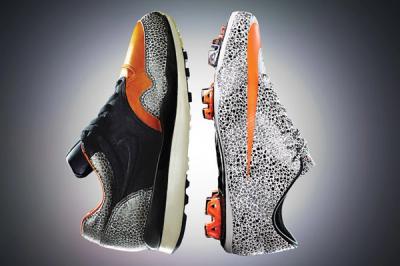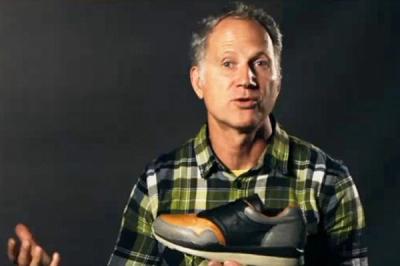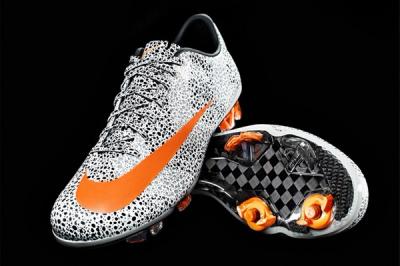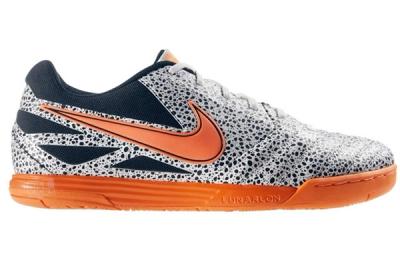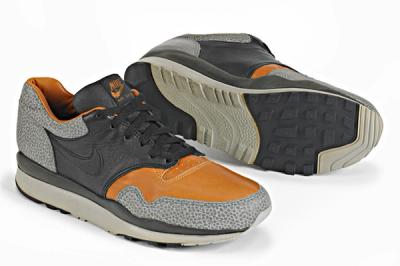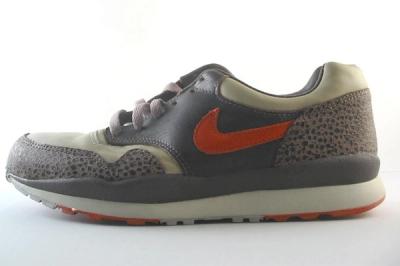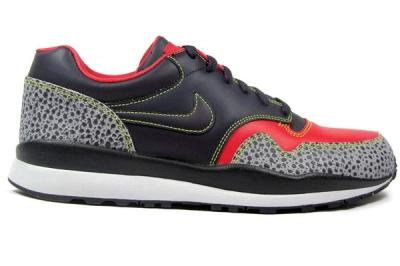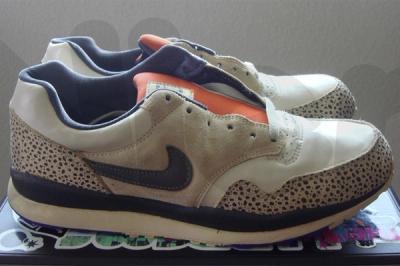Tinker Hatfield 'air Safari' Interview
When you’re the inventor of the franchise, not to mention every for the past 100 years, you really don’t need an introduction. Let’s just say is to sneakerheads what Bill Gates is to nerds. And even after 25 years of non-stop innovation, he’s still blazing into the future without any signs of slowing down. With the new Cristiano Ronaldo Mercurial Vapor SuperFly II, Nike has taken their high-tech ‘adaptive’ new football boot and slapped it with the retro-fantastico Safari ‘ostrich skin’ treatment. Tinker lets us in on how it all started and what’s in store for tomorrow...As seen in .
Hey Tinker... I was wondering what projects have you been working on recently?
Oh I've just been signing a lot of autographs mostly. It keeps me pretty fit. No, just kidding. I don't think I've had as many projects in my entire career as I have at the moment! We're working on new Air Jordans, Converse, Kobe shoes and new projects for the Olympics. And I do a lot of pro bono work, working with the City of Portland on urban renewal and the University of Oregon, redesigning facilities and uniforms. So the menu is pretty broad right now. You know when you go into a bad restaurant and you have this huge menu... that could be where I'm headed.
Well make sure you get to the dessert at least! It must be interesting for you to work on Converse shoes after a lifetime at Nike.
I've actually always been a Converse fan. I grew up wearing Chucks before there was a Nike and I ultimately switched to Adidas products when I got better and better at sports until I finally went to college and Nike had started. But I was always a Converse kid and I thought it was great when we bought the company because I always wanted to have them in my closet anyhow. So being able to contribute to the future of Converse has been pretty fun. And I'm working on a very top secret project right now!
You've worked on so many products with an incredible life span... Are you surprised that we're still talking about the Safari? Because it's kind of an oddball sneaker in the overall scheme of things...
Yeah, I always am surprised at how many people are interested in some of the older work from early in my career. But it's fun to talk about it, because it reminds me of all the innovation and the fun we had working on those projects. So on the one hand, I am kind of surprised that people want to talk about it, but on the other I'm glad that I get to have these conversations, because it reminds me of it all.
I heard you got the inspiration for that fabric from a couch? Can you talk us through that story?
During the design period of the Air Safari I was really trying hard to help Nike out of a slump. By personal aggressive behaviour by me and Mark Parker, Sandy Bodecker and a couple of others, we formed our own little SWAT team and started to work on projects that weren't like any other projects before them, which is really how Nike originally started. We weren't listening to any marketing people, we weren't listening to the conventions of the time, and certainly sales people were shot on sight if they even tried to get into our offices. So the Air Pack was the Air Max, the Air Trainer, the Air Revolution, the Air Sock and the Air Safari. I added the Air Safari to the mix as a performance running shoe with a twist. And the story is based in this very high-end designer furniture store in New York City that only had $10,000 couches and $20,000 coffee tables and so on. So I started looking at this couch that was covered in real ostrich skin and I just made a mental note of it because I'd never seen a couch in that kind of exotic leather. But as soon as I checked it out I was booted out of the store by a very snooty and arrogant clerk, who was saying that it's the only couch of its kind in the world and that I wouldn't be able to afford it and so on. And it just got me thinking that this exotic approach to design was reserved for this high-toned design crowd, with lots and lots of money. And I thought - wow, it'd be cool to take a little bit of that attitude, but mix it with a sneaker that you go out and run in or a sneaker that you would wear much more casually and you wouldn't need to be a millionaire to afford it. So I drew up an idea for the Air Safari with a stylised version of ostrich, because we didn't want to go out and kill a bunch of ostriches. And real ostrich skin is a little weird in that it actually has little bumps on it where the feathers are, so I basically put together this shoe using deer skin and this exotic embossed leather that had been buffed.
Did you ever see anyone running in it? Because it's such a crazy looking shoe, the thought of someone actually seriously running in it is pretty funny.
Yeah, I never really expected people to run in it. It's kind of like an Aston Martin... you buy a car that can go 160 miles an hour and it's a high performance machine, but you really never take it to the track and scratch it up and beat it up and put it through its paces. So I felt like the shoe should have the ability to be a real performance shoe, all the while knowing that most people would just buy it because it was really interesting and different. It had that fashion edge to it. But I've actually spoken to people who went running in them and they worked just fine, so I guess that's a good thing for Nike. Most of the time Nike are trying to develop more innovative products for real athletes and if we can add a little bit of style or panache or storytelling to the process, then that makes it all the better. In some ways you could say it was the precursor to being able to customise your shoes, irrespective of their function.
Michael Jordan seemed to be very hands-on in terms of working with you on the design of the shoes that he endorsed. How hands-on was Ronaldo in the development of the new Superfly boot?
It's probably better for Andy Kane to speak about Ronaldo's involvement. But when I was working with Michael Jordan, which was roughly about the same time I was working on the Air Pack, he said something very early on that stuck with me, which I'd never heard an athlete say before: "If I look better, I feel better, if I feel better, I play better". And that stuck with me because that wasn't something you heard back in the 1980s like that. So that just changed the game for me in terms of my approach to designing high performance products. And the Air Safari is one of the very early examples of that mentality or that philosophy.
Given the amount of choice the market is flooded with these days, do you think there is a current model that will still have an impact in 20 years, like the Air Jordan 3 or the Safari have had?
Well I try to be a bit of a student of modern culture... We live in a different world, it's always changing and I think your question could be asked of a musician or an artist or an architect or an automobile designer. There's so much more out there, it's quite possible that because of the incessant flow of new ideas and new products, any one product has a more difficult time making a bigger and more lasting statement. And I think that when I was working on some of these sneakers, there weren't so many new designs, so I was just essentially the first one to go down that road. But today it's a little bit more cluttered, let's put it that way. Having said that, what's really cool about this new soccer boot is that by actually looking at something from the past and then mixing it with this super high tech, lightweight technology, it's an incredibly fresh new product. It probably will have some pretty major impact on the way high performance shoes are going to be designed going into the future. So whether or not it'll have the same impact as earlier Jordans I don't know, but it might just open the flood gates for a whole new creative flurry of product innovation.
The adaptive part of the boot seems to be a direction that everyone would love to go down, so do you have any thoughts on adaptive footwear and where that might head?
Well one of the great futures of sports performance is to design products that do change, modify and react. And most products up to this point have been somewhat static - they do one or two things, but they pretty much stay the same. But this particular boot has a special cleat design that is retractable. So based on the hardness of the surface, the nature of the cut, how fast you're moving, these cleats actually have some variability to them. And I would call this an early step towards designing products that are more and more like the way we actually all operate, which is this reactive and variable behaviour. This new boot is a front runner, a precursor to even more things coming down the road, which is very exciting. It's really going to be a mould-breaking product and technology.
There has been a lot of discussion recently about illegal performance-enhancing footwear, which is really interesting because essentially shoe design is about making us perform better. So where do you draw the line? What's your take on what's possible in terms of being able to jump higher and run faster?
That's a great question, because it brings up a lot of complicated issues. I think it is our job to improve performance, and every once in a while, you're maybe going to cross some boundary where people feel there's an unfair advantage. That's why there are regulatory commissions for leagues in sports, so we'll leave them to deal with that. I don't think that has any impact on how I look at projects, nor probably anybody else at Nike. And if we could actually improve the jump reach of a basketball player by four or five inches, we would go right ahead and do that. And if the NBA thought that was an unfair advantage from one player to the next, that's sort of almost beside the point for us. Since Nike is one of the leaders of our industry, if we're not pushing it, everything will get stagnant and the business drops and athletes maybe lose a little bit of interest in our products. So we have to push it, push it, push it and actually we look forward to being banned from various sports around the world if we can.
Fantastic Tinker, that's a great way to end the interview! Thanks for your time.
